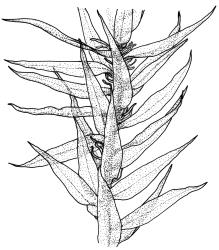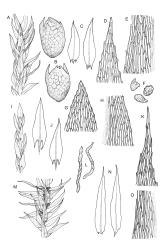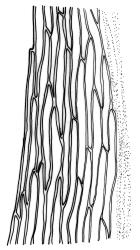Plants medium-sized, lustrous, yellow to gold-green above, becoming red below, forming loose turves on friable, non-irrigated mineral soil. Stems mostly (5–)12–20(–30) mm, mostly unbranched, pale above, usually dark red near base, sparsely beset below with densely papillose and red rhizoids, in cross-section with a strong central strand. Leaves equally and distantly spaced on stems, erect-spreading both dry and moist, narrowly lanceolate-acuminate, usually sparsely and weakly serrulate in upper half or more by projecting cell ends or sometimes nearly entire, (1.3–)1.6–2.2 mm, plane at margins, decurrent; upper and mid laminal cells linear, thin-walled but not lax, mostly 120–180 × c. 8 µm. Costa ending below the leaf apex, concolorous or red near insertion, in cross-section with an abaxial stereid band, and weakly differentiated guide cells and adaxial stereids. Axillary gemmae usually present, numerous or occasionally sparse in upper leaf axils, linear, apparently dextrorse, many-celled, strongly bent or twisted both moist and dry, (110–)175–350(–410) µm, with (0–)1–2 single-celled peg-like leaf primordia.
Sexuality and sporophytes uncertain.
Vitt 1971, figs 23–27.
Features that distinguish P. ochii from P. wahlenbergii are discussed under the latter species. Pohlia ochii and other gemmae-bearing species of Pohlia can be differentiated mainly by the morphology and number of their axillary gemmae, as outlined in the key. In the absence of gemmae, recognition can be very difficult and it seems best to rely on leaf shape, texture, toothing, and the nature of the insertion (± lanceolate, delicate, often serrulate, and decurrent in this species, poorly represented in Plate 000, N). The thin-walled upper laminal cells, its broad elevational range, and its presence on sheltered and friable soil can sometimes facilitate the naming of difficult specimens.
Confusion between P. ochii and Philonotis tenuis is possible, in part because the latter occupies similar (but often more calcareous) soil habitats. The laminal cells of P. ochii are smooth and linear, while those of Philonotis tenuis are prorate and much shorter (<32 µm). Pohlia ochii is decidedly more lustrous. The gemmae in P. ochii are very numerous and have peg-like primordia, while those of Philonotis tenuis are fewer (to five per leaf axil) and have laminate leaf primordia. The costa in the present species ends in the acumen, while that of Philonotis tenuis is excurrent. Once recognised, the two species present very different aspects.
NI: Taranaki (Mt Taranaki), Hawke’s Bay (track to Sunrise Hut), Wellington (Mt Ruapehu, John McDonald Road, Akatarawa Range); SI: Nelson, Marlborough (Black Birch Range, Mt Fyffe), Canterbury (Cora Lynn, Banks Peninsula), Westland (Sewell Peak, Madmans Creek, Newton Range, near Jackson Bay), Otago (Lindis Pass, Crown Range, Queenstown, Paradise, Black Gully, Leith Saddle), Southland (Stuart Range, Borland Burn, Grebe River, Percy Stream); A; C.
Endemic.
On friable non-humic soil. On steep and shaded banks, gravel banks, road cuts, in rock crevices, and similar substrates, very rarely on wood. Associated with a range of rock types (e.g., basalt, greywacke, gneiss) but avoiding calcareous substrates. Occasionally in the beds of intermittent watercourses, but not associated with seepages or permanently irrigated sites. Most often in southern beech dominated forest, but also occurring in podocarp forests, grasslands and scrublands. Documented from 660 m (John McDonald Road) to c. 1550 m (Bruce Road, Mt Ruapehu) on the North I. and from 60 m (Ōpārara River) to 1300 m (Mt Fyffe) on the South I. Very commonly associated mosses are Ditrichum difficile and Mittenia plumula, while Bartramia papillata, Catagonium nitens, Ditrichum cylindricarpum, D. punctulatum, Leptotheca gaudichaudii, Philonotis tenuis, Pohlia australis, and P. cruda and species of Telaranea are less frequently associated.
Sporophytes are extremely rare in P. ochii, and both the sexuality and the nature of the sporophytes are uncertain. One collection from Treble Cone (Otago L.D., P. Beveridge AX-1a, WELT M037925) bears sporophytes clearly attached to representative and gemmae-bearing shoots. This collection has paroicous perichaetia borne terminally on short (≤4 mm) shoots, with perichaetial leaves longer than vegetative, to at least 2.5 mm. The setae are straight, c. 7 mm, yellow-brown, and the capsules are clavate and weakly inclined when moist, 3.0–4.0 mm, with a long neck nearly equal to the urn. Peristome details are not observable and the few spores seen are 21–24 µm.
A collection from Borland Burn (J.E. Beever 64-12b, CHR 462055) consisting predominantly of representative and propaguliferous shoots of P. ochii also includes a small number of immature capsules. These differ markedly from the Treble Cone material, but no unambiguous connection between gemmae-bearing shoots and the sporophytes can be demonstrated. The perichaetia bear only archegonia (the plants are apparently dioicous), the flexuose setae are c. 35 mm, and the immature capsules are ± horizontal, broadly obovoid, and c. 2.8 mm long with an only moderately defined neck. It is not possible to reconcile these two morphologically different sporophytes, and the study of better fruiting material is required to clarify both the sexuality and sporophyte morphology of this species.









